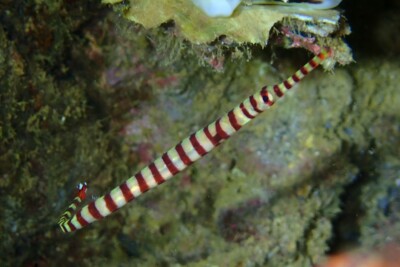spotted eagle ray
| Scientific name | Aetobatus ocellatus |
|---|---|
| Descriptor | Kühl |
| Year of description | 1823 |
| IUCN category (World) | EN |
| Family | Aetobatidae |
| Genus | Aetobatus |


Introduction
Aetobatus ocellatus, commonly known as spotted eagle ray, is a salt water fish.
This sheet is currently being prepared. The texts currently proposed come from our data model or are being drafted. To request priority for this content, you can write to us HERE.
Who is it?
Morphology
-
Type
-
Average size180 cm
-
Maximum size300 cm
-
Patternponctuations
-
Type
-
Average size180 cm
-
Maximum size300 cm
-
Patternponctuations
How to recognize This fish ?
The spotted eagle ray measures between 180 and 300 cm. This fish is bicolore with a predominantly noir and blanc body. The also has blanc ponctuations.
Behaviour & Life cycle
-
dietcarnivorous
-
Sociabilityliving in a group or alone
-
territorialNo
-
Way of livingdiurnal
The spotted eagle ray is a fish living in a group or alone naturally found near the bottom. This species is carnivorous .
Although the spotted eagle ray is non-territorial, it is sometimes aggressive towards other species.
Reproduction
-
Reproductionovovivipare
The spotted eagle ray is a fish ovovivipare.
Life-threatening species
-
VenomousYes
This species is venomous and can cause serious injuries when touched. In the most serious cases, it can cause death.
Origin and distribution

What is its habitat?
Natural environment characteristics
-
Temperature24 - 29 °C
-
Depth1 - 60 m
Biotope presentation
The spotted eagle ray is most often found at a depth between 1m and 60m. However, it is not impossible to find this species at other depths.
Species of the same biotope
To go further
Sources & Contributions
Participation & Validation
The Fishipedia team and specialist contributors are committed to providing high-quality content. However, although the information comes from scientific sources or testimonials from specialists, the cards may contain inaccuracies.

Benoit Chartrer
Translation
Translation done with the valuable contribution of our translators, who make this information available to a wider audience. We sincerely thank them for their commitment.
Scientific partners
Tags
#Aetobatidae
#Aetobatus
#barrière de corail
#fonds rocheux
#fonds vaseux
#herbier
#zone mixte
#Ray
#Bay of Bengal
#Persian Gulf
#Great Barrier Reef
#mer d'Oman
#Philippine Sea
#Sea of Japan
#Red Sea
#South East Asian Seas
#Indonesian seas
#East Indian Ocean
#western Indian Ocean
#Réunion
#New Caledonia
#French Polynesia
Same genus
Species of the same biotope


















